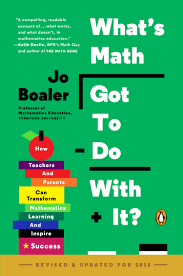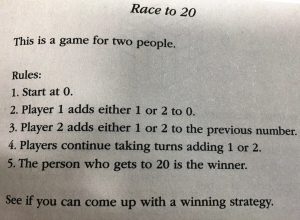
Youth Services Librarian Jennifer Leveck (pictured above) knows kids and books. She works at the Franklin Avenue Branch of the Des Moines Public Library System. From preK to teen, she’s in charge of bringing the best youth programming and books to the community. We asked her to recommend some great middle grade titles with STEM elements for kids in grades 2nd-7th. Best of all, the library has copies (often multiple) of all these books.
“There are a lot more books coming out where the main character has a STEM interest–coding, gaming, scientific ways of thinking–and kids are checking them out,” Leveck noted. “Kids get excited to read about characters who like the same things they like.”
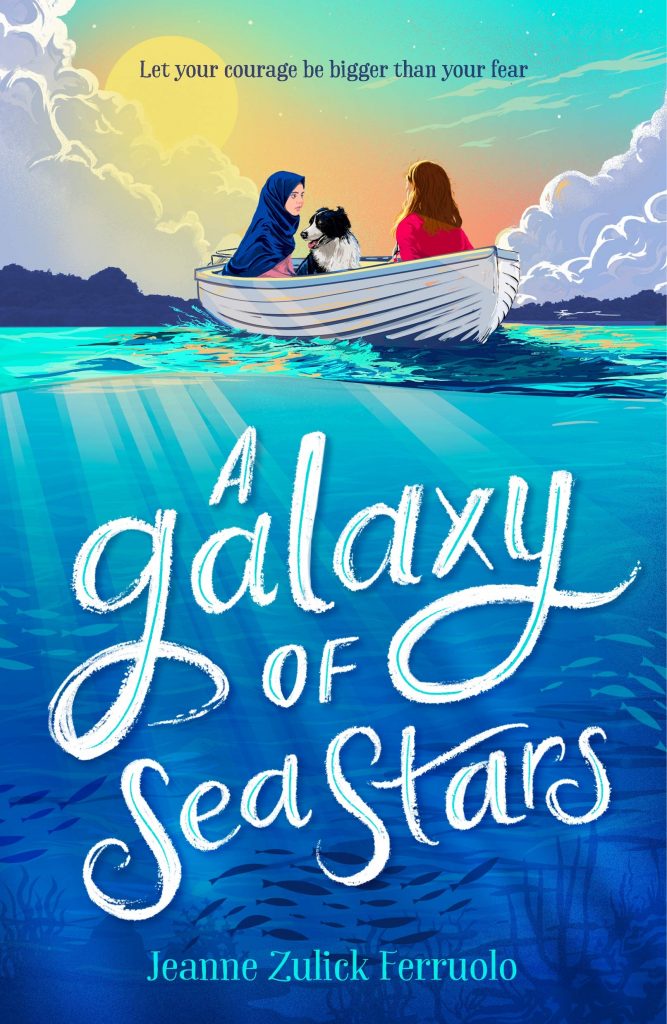
Galaxy of Sea Stars by Jeanne Zulick Ferruolo
Overview from the Publisher: A heartwarming story about family, loyalty, and the hard choices we face in the name of friendship. Eleven-year-old Izzy feels as though her whole world is shifting, and she doesn’t like it. She wants her dad to act like he did before he was deployed to Afghanistan. She wants her mom to live with them at the marina where they’ve moved instead of spending all her time on Block Island. Most of all, she wants Piper, Zelda, and herself—the Sea Stars—to stay best friends, as they start sixth grade in a new school.
Everything changes when Izzy’s father invites his former interpreter’s family, including eleven-year-old Sitara, to move into the marina’s upstairs apartment. Izzy doesn’t know what to make of Sitara―with her hijab and refusal to eat cafeteria food―and her presence disrupts the Sea Stars. But in Sitara Izzy finds someone brave, someone daring, someone who isn’t as afraid as Izzy is to use her voice and speak up for herself. As Izzy and Sitara grow closer, Izzy must make a choice: stay in her comfort zone and risk betraying her new friend, or speak up and lose the Sea Stars forever.
What Jen loves about it: “This book is about the ocean and family dynamics. Placed in a coastal town, I love that the main character’s passion is mapping the ocean floor. It’s while she is measuring depths along the coast that the story develops. This book deals with big issues: friendship, divorce, mental health issues, bullying–but the plot and STEM elements are incorporated together so well that it’s never clunky.”
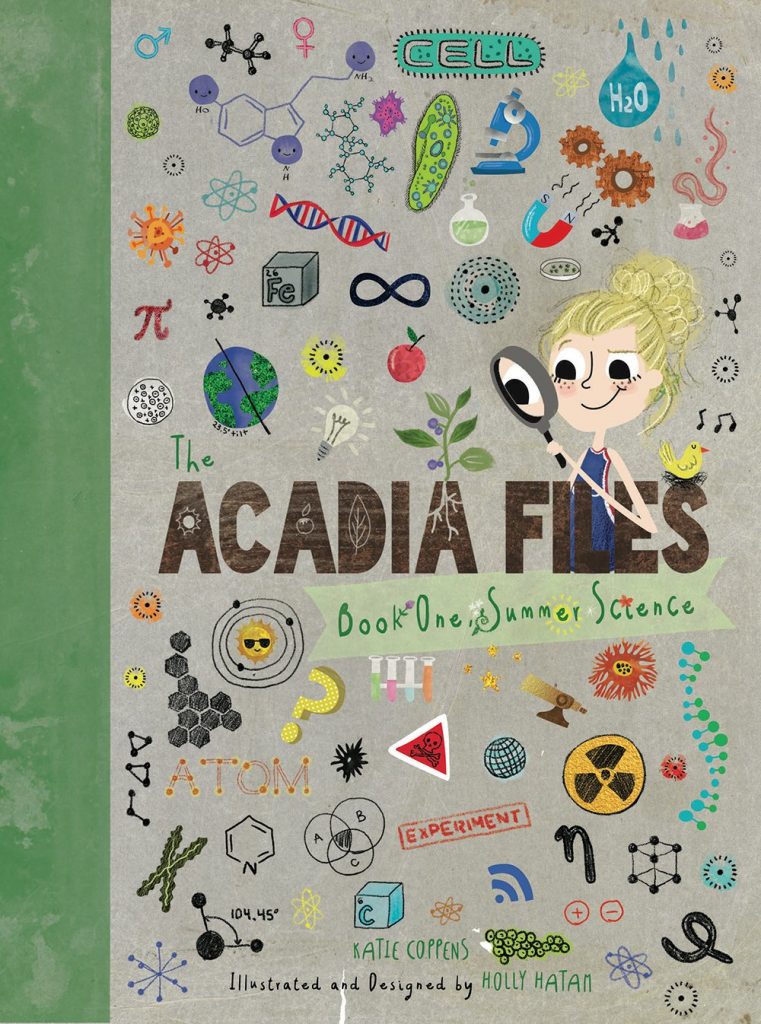
The Acadia Files series by Katie Coppens and Holly Hatam
Overview from the Publisher: The book presents five summer stories, each one followed by Acadia’s science notebook pages with her simple explanations and lively, whimsical drawings of natural phenomena. The Acadia Files is a fun introduction to the wonders of science, using real-world scenarios to make scientific inquiry relatable and understandable. Parents and educators can use The Acadia Files to let kids discover for themselves what it’s like to be curious about the world and to satisfy that curiosity with scientific thinking.
What Jen loves about it: “The design of this book is really clever. It’s set up like a scientific notebook. The main character takes an issue in life and applies the scientific method to solve problems around her. The author incorporates complex topics, like genetics, and breaks it down into little tidbits that readers understand. We’re seeing more and more visual books like this, complete with graphs and illustrations. When kids graduate from picture books or early graphic chapter books, this format makes an easy transition.”

Cog by Greg van Eekhout and Beatrice Blue
Overview from the Publisher: Five robots. One unforgettable journey. Their programming will never be the same. Wall-E meets The Wild Robot in this middle grade instant classic about five robots on a mission to rescue their inventor from the corporation that controls them all.
Cog looks like a normal twelve-year-old boy. But his name is short for “cognitive development,” and he was built to learn. But after an accident leaves him damaged, Cog wakes up in an unknown lab—and Gina, the scientist who created and cared for him, is nowhere to be found. Surrounded by scientists who want to study him and remove his brain, Cog recruits four robot accomplices for a mission to find her. Cog, ADA, Proto, Trashbot, and Car’s journey will likely involve much cognitive development in the form of mistakes, but Cog is willing to risk everything to find his way back to Gina.
What Jen loves about it: “The main character is a robot, as are most of the characters. The author does such a good job of developing characters, including one named Trashbot. As they try to escape the evil corporation holding them prisoner, you really become invested in their lives.”
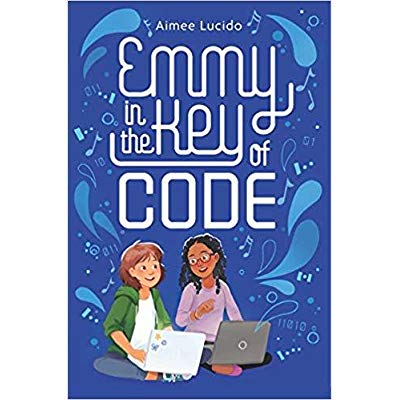
Emmy in the Key of Code by Aimee Lucido
Overview from the Publisher: In this innovative middle grade novel, coding and music take center stage as new girl Emmy tries to find her place in a new school. Perfect for fans of the Girls Who Code series and The Crossover.
In a new city, at a new school, twelve-year-old Emmy has never felt more out of tune. Things start to look up when she takes her first coding class, unexpectedly connecting with the material—and Abigail, a new friend—through a shared language: music. But when Emmy gets bad news about their computer teacher, and finds out Abigail isn’t being entirely honest about their friendship, she feels like her new life is screeching to a halt. Despite these obstacles, Emmy is determined to prove one thing: that, for the first time ever, she isn’t a wrong note, but a musician in the world’s most beautiful symphony.
What Jen loves about it: “This novel is in verse, so each chapter is a short poem. Both of Emmy’s parents are musicians, so the novel starts out incorporating musical words into the story. For example, the author writes about an “allegro smile.” But Emmy doesn’t love music as much as her parents do. She likes to code. By the end of the story, the musical words transition, and she takes on a coding mindset. In addition to being a good story, it’s really helpful to follow along with someone just beginning to learn code.”
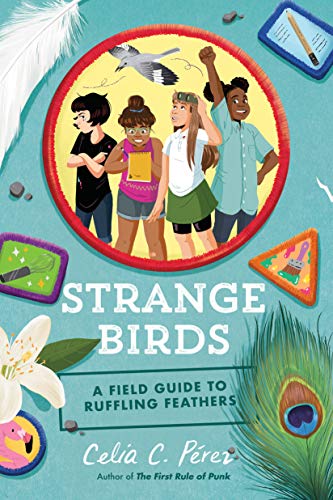
Strange Birds: A Field Guide to Ruffling Feathers by Celia C. Perez
Overview from the Publisher: From the award-winning author of The First Rule of Punk comes the story of four kids who form an alternative Scout troop that shakes up their sleepy Florida town.
When three very different girls find a mysterious invitation to a lavish mansion, the promise of adventure and mischief is too intriguing to pass up. Ofelia Castillo (a budding journalist), Aster Douglas (a bookish foodie), and Cat Garcia (a rule-abiding birdwatcher) meet the kid behind the invite, Lane DiSanti, and it isn’t love at first sight. But they soon bond over a shared mission to get the Floras, their local Scouts, to ditch an outdated tradition. In their quest for justice, independence, and an unforgettable summer, the girls form their own troop and find something they didn’t know they needed: sisterhood.
What Jen loves about this book: “This book is relevant to today’s climate. It deals with a friendship based on social activism. An eclectic group of girls come together to protest the unnecessary use of a feathered hat in one of their town’s ceremonies. I really liked all of the girls. They makes mistakes along the way, but that just strengthens their friendships.”

Nikki Tesla and the Ferret Proof Death Ray by Jess Keating
Overview from the Publisher: Ocean’s 11 meets Spy School in this hilarious illustrated middle-grade series featuring the world’s greatest minds. “Let the official record show that, I, Nikki Tesla, did not intend to destroy the world.”
There are only so many times a kid can invent an instrument of global destruction without getting grounded. So when Nikki’s death ray accidentally blows up her bedroom, she’s sent to the only place that can handle her. Genius Academy is a school for history’s greatest brains. Nikki feels like an outsider thanks to a terrible secret she can’t let anyone discover. But when her death ray is stolen, Nikki must stop worrying about fitting in and learn to play nice with her new classmates.
What Jen loves about the book: This is one of those action-packed boarding school books. Nikki gets sent away because she accidentally blows up part of her house. She creates tech inventions that always go wrong in some way. I like that the kids are on their own and have to ban together to save the world. In addition, all of the characters are named after famous geniuses throughout history, and they go on to inhabit the main qualities of each.”
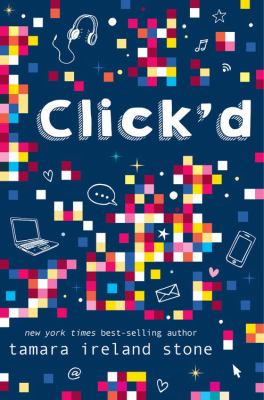
Click’d by Tamara Ireland Stone
Overview from the Publisher: Click’d is a thrilling book about a seventh-grade girl named Allie Navarro, who creates an app that goes unexpectedly viral, turning Allie into a school celebrity.
Unfortunately, the glow of her fame starts to fade as an unanticipated bug threatens the privacy of her peers, causing embarrassment and havoc for those closest to her. Will Allie choose to shut down her game, knowing that her place in the Games for Good competition is on the line, or will she try to hide the problems in her application in hopes of being declared the big winner?
What Jen loves about the book: “I love that the main character makes an app that gets away from her. She has the best of intentions, but things still go wrong. It’s about creating technology and then realizing there are issues and problems with it. What happens if it hurts someone? Who is responsible for that? It’s very relevant to technology development today.”
THANK YOU!
To Jen Leveck for your spring STEM recommendations. If you find yourself with some extra time over spring break, head on over to the library for these titles and scads more! If you have trouble finding the perfect book, just ask one of the librarians in the children’s area. They’ll work some book magic and come up with an idea list.
If you do read one of these books (or another STEM-oriented title), please consider being interviewed for this blog. We’d love to hear from more readers! Email the Hub if you’re interested.
Happy reading and have a healthy spring break,
The SC STEM Hub
COVID-19 Library Updates
Located in Des Moines, Franklin and Forest Avenue are our closest libraries. We inquired as to what practices they were enacting to keep us all safe. Click HERE to learn more about the city’s plan. Or visit your local library’s website and learn how to safely use the library during the COVID-19 outbreak.







